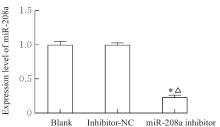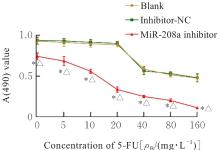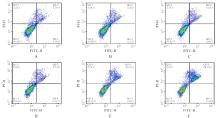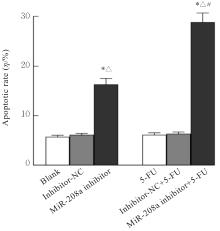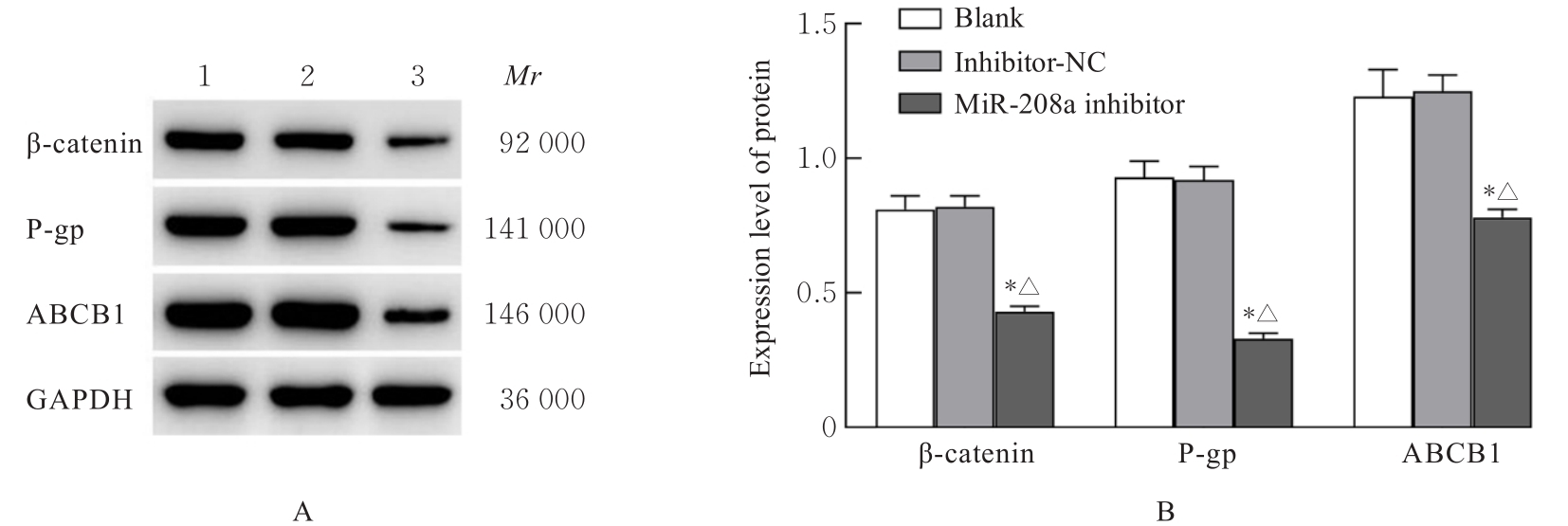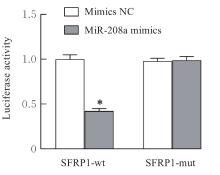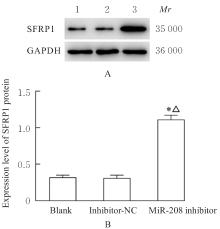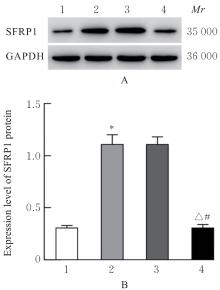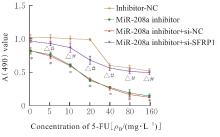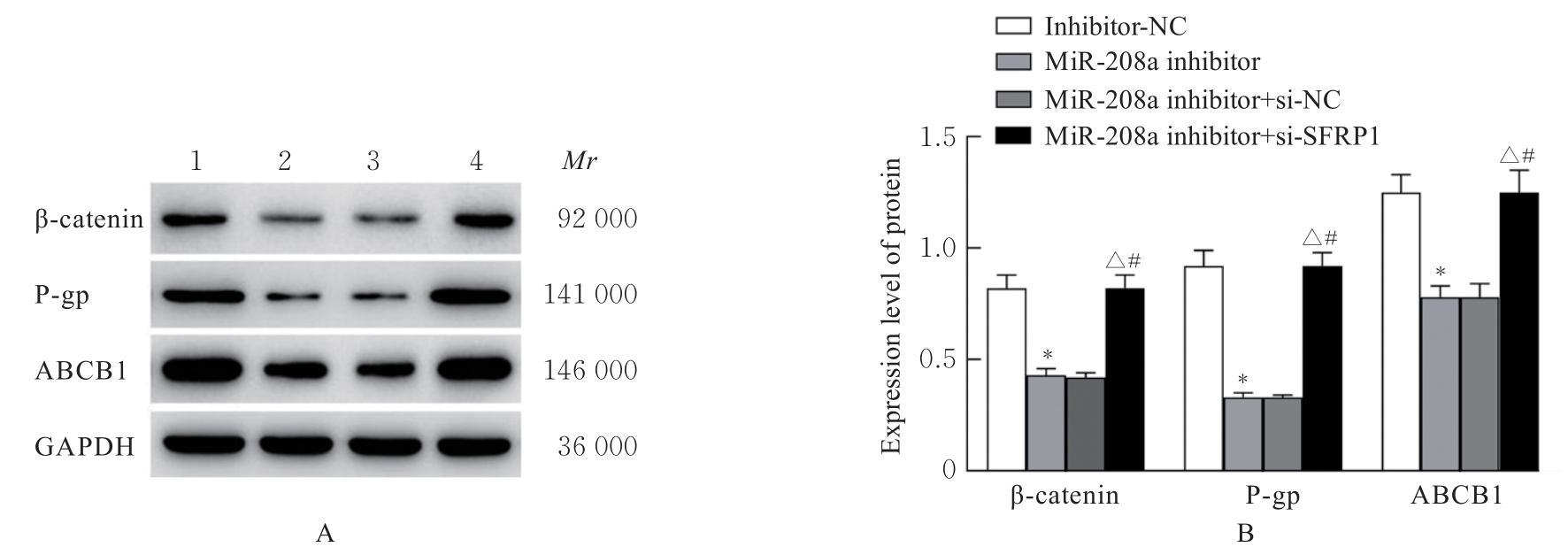Journal of Jilin University(Medicine Edition) ›› 2024, Vol. 50 ›› Issue (4): 947-955.doi: 10.13481/j.1671-587X.20240408
• Research in basic medicine • Previous Articles Next Articles
Improvement effect of down-regulation of miR-208a on 5-FU resistance in colorectal cancer cells through targeting SFRP1 for mediating Wnt signaling pathway
Bingbing HU1,Kangning LUO2( ),Su PENG2,Yuzhong ZHOU2,Maoliang CHEN2,Changhua LIU2
),Su PENG2,Yuzhong ZHOU2,Maoliang CHEN2,Changhua LIU2
- 1.Department of Vascular Hernia Pediatric,Second Affiliated Hospital,Hengyang Medical School,University of South China,Hengyang 421001,China
2.Department of Gastrointestinal Surgery,Second Affiliated Hospital,Hengyang Medical School,University of South China,Hengyang 421001,China
-
Received:2023-08-03Online:2024-07-28Published:2024-08-01 -
Contact:Kangning LUO E-mail:lkn1987622@126.com
CLC Number:
- R735.1
Cite this article
Bingbing HU,Kangning LUO,Su PENG,Yuzhong ZHOU,Maoliang CHEN,Changhua LIU. Improvement effect of down-regulation of miR-208a on 5-FU resistance in colorectal cancer cells through targeting SFRP1 for mediating Wnt signaling pathway[J].Journal of Jilin University(Medicine Edition), 2024, 50(4): 947-955.
share this article
| 1 | ISLAM M R, AKASH S, RAHMAN M M, et al. Colon cancer and colorectal cancer: prevention and treatment by potential natural products[J]. Chem Biol Interact, 2022, 368: 110170. |
| 2 | PATY P B, GARCIA-AGUILAR J. Colorectal cancer[J]. J Surg Oncol, 2022, 126(5): 881-887. |
| 3 | BLONDY S, DAVID V, VERDIER M, et al. 5-Fluorouracil resistance mechanisms in colorectal cancer: from classical pathways to promising processes[J]. Cancer Sci, 2020, 111(9): 3142-3154. |
| 4 | ZOU Y T, ZHENG S Q, XIAO W K, et al. circRAD18 sponges miR-208a/3164 to promote triple-negative breast cancer progression through regulating IGF1 and FGF2 expression[J]. Carcinogenesis, 2019, 40(12): 1469-1479. |
| 5 | LIU L, WANG W Z, GAO S, et al. MicroRNA-208a directly targets Src kinase signaling inhibitor 1 to facilitate cell proliferation and invasion in non-small cell lung cancer[J]. Mol Med Rep, 2019, 20(4): 3140-3148. |
| 6 | QIN F, TANG H Y, ZHANG Y, et al. Bone marrow-derived mesenchymal stem cell-derived exosomal microRNA-208a promotes osteosarcoma cell proliferation, migration, and invasion[J]. J Cell Physiol, 2020, 235(5): 4734-4745. |
| 7 | 王晓凤, 田 勇, 柳艳飞, 等. SFRP1/FZD6抑制Wnt/ β-catenin 信号通路对 A549 肺癌细胞生物学行为的影响[J]. 世界最新医学信息文摘, 2017, 17(33):14-16, 20. |
| 8 | 罗康宁, 刘昌化. 山楂酸通过调控DNA损伤修复逆转结人结肠癌HT-29细胞5-氟尿嘧啶耐药[J]. 中药材, 2021, 44(10): 2430-2434. |
| 9 | 刘久莲, 刘 童, 高善语. MicroRNA在结直肠癌耐药及治疗中作用的研究进展[J]. 中国肿瘤生物治疗杂志, 2023, 30(5): 438-444. |
| 10 | SHAW P, LOKHOTIYA K, KUMARASAMY C, et al. Mapping research on miRNAs in cancer: a global data analysis and bibliometric profiling analysis[J]. Pathophysiology, 2022, 29(1): 66-80. |
| 11 | 李新玲, 吴振国, 张立海, 等. MiR-208a 促进非小细胞肺癌 A549 细胞增殖、 侵袭和迁移的功能和机制研究[J]. 天津医药, 2021, 49(3): 242-247, 338. |
| 12 | YANG B L, LIU G Q, LI P, et al. Circular RNA CUL2 regulates the development of colorectal cancer by modulating apoptosis and autophagy via miR-208a-3p/PPP6C[J]. Aging, 2022, 14(1): 497-508. |
| 13 | CUI H B, GE H E, WANG Y S, et al. MiR-208a enhances cell proliferation and invasion of gastric cancer by targeting SFRP1 and negatively regulating MEG3[J]. Int J Biochem Cell Biol, 2018, 102: 31-39. |
| 14 | ZHANG H, XU H W, ASHBY C R Jr, et al. Chemical molecular-based approach to overcome multidrug resistance in cancer by targeting P-glycoprotein (P-gp)[J]. Med Res Rev, 2021, 41(1): 525-555. |
| 15 | JIANG L, ZHANG Y, GUO L H, et al. Exosomal microRNA-107 reverses chemotherapeutic drug resistance of gastric cancer cells through HMGA2/mTOR/P-gp pathway[J]. BMC Cancer, 2021, 21(1): 1290. |
| 16 | AIRES V, COLIN D J, DOREAU A, et al. P-glycoprotein 1 affects chemoactivities of resveratrol against human colorectal cancer cells[J]. Nutrients, 2019, 11(9): 2098. |
| 17 | 霍迪妮, 聂小博. 经典Wnt信号通路与肿瘤免疫耐受的研究进展[J]. 医学综述, 2022, 28(14): 2808-2813. |
| 18 | 田宇佳, 魏 铭, 赵 辉. Wnt/β-catenin信号通路在肿瘤干细胞中的作用研究进展[J]. 解放军医学杂志, 2022, 47(8): 831-837. |
| 19 | 伍 丹, 伍尤华. Wnt拮抗因子SFRP1与肿瘤相关性的研究进展[J]. 现代医药卫生, 2015, 31(7): 1016-1019. |
| 20 | 沈二栋, 翁 洁, 文 芳, 等. miRNA-31靶向SFRP1介导Wnt/β-catenin信号通路对人胃癌细胞生物学特性的调控作用[J]. 肿瘤药学, 2019, 9(4): 578-585. |
| 21 | HU J H, ZHAO W, HUANG Y J, et al. MiR-1180 from bone marrow MSCs promotes cell proliferation and glycolysis in ovarian cancer cells via SFRP1/Wnt pathway[J]. Cancer Cell Int, 2019, 19: 66. |
| 22 | WANG Z C, LI R J, HE Y S, et al. Effects of secreted frizzled-related protein 1 on proliferation, migration, invasion, and apoptosis of colorectal cancer cells[J]. Cancer Cell Int, 2018, 18: 48. |
| [1] | Zhibo XU,Xinmiao JIANG,Yuqi ZHEN,MA Quzhen BAI,Mengyao SUN,Xiuping MENG. Effect of chlorhexidine on drug resistance and pathogenicity of Enterococcus faecalis and its mechanism [J]. Journal of Jilin University(Medicine Edition), 2024, 50(3): 676-681. |
| [2] | Ying ZHANG,Zhaohui WAN,Xianxun JIANG. Effect of over-expression of NDRG1 on resistance of castration-resistant prostate cancer resistant cell line C4-2/ENZA and its mechanism [J]. Journal of Jilin University(Medicine Edition), 2024, 50(3): 708-717. |
| [3] | ERDEMUTU,Yanyan WANG,Yutong LI,Guilin CHEN,Junrui WANG. Comparison of drug resistance of MRSA clinical strains from respiratory tract and non-respiratory tract specimens and their molecular epidemiological characteristics [J]. Journal of Jilin University(Medicine Edition), 2024, 50(2): 422-430. |
| [4] | Chunyan KANG,Xiuzhi ZHANG,Huicong ZHOU,Jie CHEN. Effect of downregulating proline-rich protein 11 expression on drug resistance of esophageal cancer drug resistant cell EC9706/DDP and its mechanism [J]. Journal of Jilin University(Medicine Edition), 2024, 50(1): 113-119. |
| [5] | Aiying CHEN,Jinwen JIANG,Hui ZHANG. Network pharmacology and molecular docking analysis based on mechanism of Huangqin Tang in treatment of colorectal cancer [J]. Journal of Jilin University(Medicine Edition), 2024, 50(1): 208-220. |
| [6] | Meng LIU,Xiaodong HUANG,Zheng HAN,Qingxi ZHU,Jie TAN,Xia TIAN. Effect of cadherin-17 on proliferation and apoptosis of colorectal cancer cells and its PI3K/AKT/mTOR signaling pathway regulatory mechanism [J]. Journal of Jilin University(Medicine Edition), 2023, 49(4): 1008-1017. |
| [7] | Shan LIU,Zhaodong XING,Ping HUANG. Effect of expression of miR-17-5p in exosomes derived from colorectal cancer cells on chemosensitivity of colorectal cancer cells and its mechanism [J]. Journal of Jilin University(Medicine Edition), 2023, 49(4): 975-984. |
| [8] | Shengyu YAN,Changhua LIU,Zhijie XU,Yating DING,Yafeng XIE,Qiao ZHANG,Wanying LIU. Effect of lncRNA PAX8-AS1 on proliferation, apoptosis and invasion of colorectal cancer cells and its mechanism [J]. Journal of Jilin University(Medicine Edition), 2023, 49(3): 656-664. |
| [9] | Jiaojiao XUE,Lei HAO,Yuxiu ZHANG,Heyang DAI,Lixia ZHANG,Shaowei GUO,Jingjing ZHANG,Yang LI,Qingxia LI. Effect of Huaier aqueous extract on breast cancer tamoxifen-resistant LCC2 cells and its mechanism [J]. Journal of Jilin University(Medicine Edition), 2023, 49(3): 714-721. |
| [10] | Jinjin YUE,Yixin PANG,Xiumei ZHANG. Regulatory effect of silent information regulator 2 on aerobic glycolysis and growth and proliferation of colorectal cancer cells and its mechanism [J]. Journal of Jilin University(Medicine Edition), 2023, 49(2): 385-394. |
| [11] | Yanan MA,Bing TAN,Lei XU,Jiandong ZHANG. Detection of drug resistance genes of Acinetobacter baumannii in sputum samples of ICU patients by real-time fluorescence quantitative PCR method and its evaluation [J]. Journal of Jilin University(Medicine Edition), 2022, 48(6): 1623-1628. |
| [12] | Yan SUN,Xinhua DONG,Dongying LI,Qingfen ZHENG,Huiyu YANG,Bingrong LIU. Investigation and analysis on cognition of first-degree relatives of patients with colorectal cancer on colorectal cancer screening [J]. Journal of Jilin University(Medicine Edition), 2022, 48(4): 1065-1070. |
| [13] | Shunjia SONG,Xinying WANG,Feifei JIANG,Huijian JIA,Yuan ZHAO,Zhiping YANG,Liyuan SUN,Yundong ZHAO. Resistance rates of Helicobacter pylori to clarithromycin, metronidazole, and levofloxacin and mutation characteristics of their related drug resistance genes [J]. Journal of Jilin University(Medicine Edition), 2022, 48(3): 630-637. |
| [14] | Qiuting CAO,Jingchun HAN,Xiaofei ZHANG. Effect of silencing helicase BLM gene on chemotherapy sensitivity of irinotecan in colorectal cancer cells and its mechanism [J]. Journal of Jilin University(Medicine Edition), 2022, 48(3): 657-667. |
| [15] | Qinghui WANG,Bo LI,Chuancui HU,Mingchao NIE,Xiaomei ZHENG. Effects of miR-107 on regulation of immune escape and taxol resistance of ovarian cancer cells [J]. Journal of Jilin University(Medicine Edition), 2022, 48(3): 734-743. |
|
